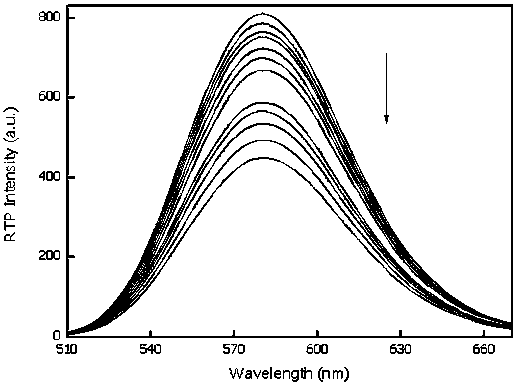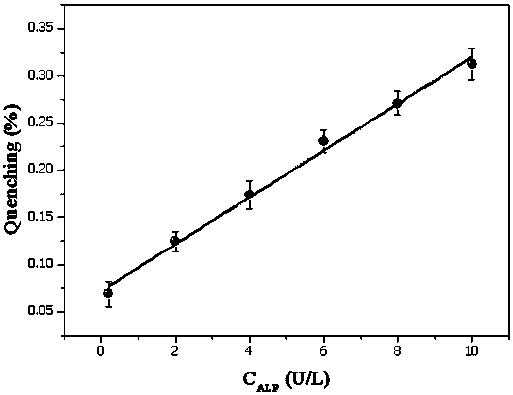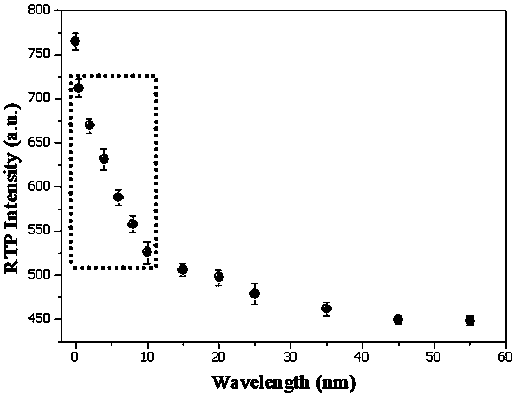Room-temperature phosphorescence detection method of alkaline phosphatase and application thereof
A detection method, room temperature phosphorescence technology, applied in fluorescence/phosphorescence, biochemical equipment and methods, microbial determination/inspection, etc., can solve the problems of high cost, complex detection process, large interference, etc. Good compatibility and high sensitivity
- Summary
- Abstract
- Description
- Claims
- Application Information
AI Technical Summary
Problems solved by technology
Method used
Image
Examples
Embodiment 1
[0031] Example 1, room temperature phosphorescence detection of alkaline phosphatase in human serum
[0032] The first step is to prepare Mn-doped ZnS quantum dots
[0033] β-cyclodextrin, Zn(Ac) 2 and Mn(Ac) 2 Mix according to the molar ratio of 3.5:1:0.05, adjust the pH value of the system to 10.5 with NaOH, protect with nitrogen, and stir magnetically at room temperature for 40 minutes; then use a syringe to quickly add Zn(Ac) 2 Na 2 S, continue to react at room temperature for 30 min; then heat the solution to 70° C., and age in air for 1.5 h to obtain a crude product of β-CD-coated Mn:ZnS quantum dots. Sediment the quantum dots with the same volume of absolute ethanol, centrifuge at high speed, pour off the supernatant, and vacuum dry at room temperature for 24 hours to obtain the desired solid powder of quantum dots.
[0034] The second step is to prepare Mn:ZnS quantum dot mother liquor:
[0035]Weigh 50mg of Mn:ZnS quantum dots, and dilute it in a 100mL volumetric...
Embodiment 2
[0045] Example 2, room temperature phosphorescence detection of alkaline phosphatase in serum
[0046] The first step is to prepare Mn-doped ZnS quantum dots:
[0047] β-cyclodextrin, Zn(Ac) 2 and Mn(Ac) 2 Mix at a molar ratio of 3.5:1:0.03, adjust the pH of the system to 10.5 with NaOH, protect with nitrogen, and stir magnetically at room temperature for 40 minutes; then use a syringe to quickly add Zn(Ac) 2 Equimolar Na 2 S, continue to react at room temperature for 20 min; then heat the solution to 50° C., and age in air for 1.5 h to obtain a crude product of β-CD-coated Mn:ZnS quantum dots. Sediment the quantum dots with the same volume of absolute ethanol, centrifuge at high speed, pour off the supernatant, and vacuum dry at room temperature for 24 hours to obtain the desired solid powder of quantum dots.
[0048] The second step is to prepare Mn:ZnS quantum dot mother liquor:
[0049] Weigh 50mg of Mn:ZnS quantum dots, and dilute it in a 100mL volumetric flask with ...
Embodiment 3
[0059] Example 3, room temperature phosphorescence detection of alkaline phosphatase in serum
[0060] The first step is to prepare Mn:ZnS quantum dots:
[0061] β-cyclodextrin, Zn(Ac) 2 and Mn(Ac) 2 Mix at a molar ratio of 3.5:1:0.04, adjust the pH of the system to 10.5 with NaOH, protect with nitrogen, and stir magnetically at room temperature for 40 minutes; then quickly add Zn(Ac) 2 Equimolar Na 2 S, continue to react at room temperature for 20 min; then heat the solution to 50 °C, and age in air for 2 h to obtain the crude product of β-CD-coated Mn:ZnS quantum dots. Sediment the quantum dots with the same volume of absolute ethanol, centrifuge at high speed, pour off the supernatant, and dry in vacuum at room temperature for 24 h to obtain the desired solid powder of quantum dots.
[0062] The second step is to prepare Mn:ZnS quantum dot mother liquor:
[0063] Weigh 50 mg of Mn:ZnS quantum dots, and dilute it in a 100 mL volumetric flask with secondary deionized wat...
PUM
 Login to View More
Login to View More Abstract
Description
Claims
Application Information
 Login to View More
Login to View More - R&D
- Intellectual Property
- Life Sciences
- Materials
- Tech Scout
- Unparalleled Data Quality
- Higher Quality Content
- 60% Fewer Hallucinations
Browse by: Latest US Patents, China's latest patents, Technical Efficacy Thesaurus, Application Domain, Technology Topic, Popular Technical Reports.
© 2025 PatSnap. All rights reserved.Legal|Privacy policy|Modern Slavery Act Transparency Statement|Sitemap|About US| Contact US: help@patsnap.com



